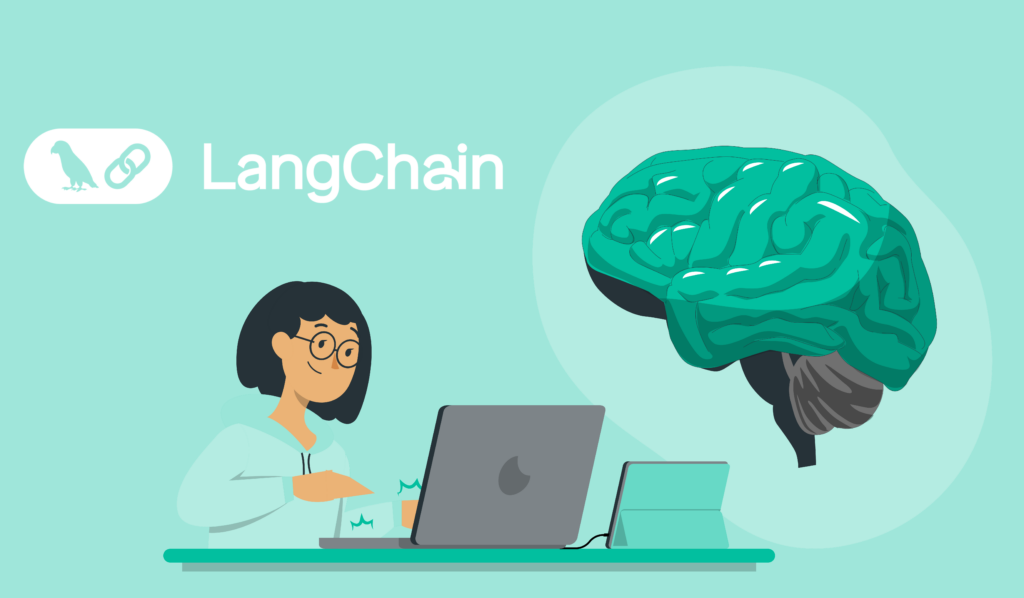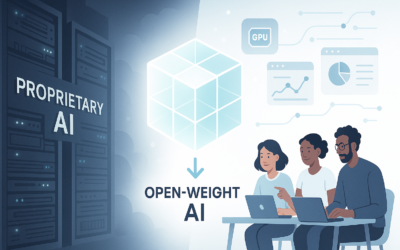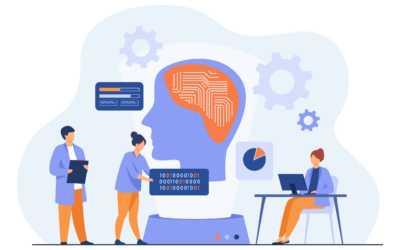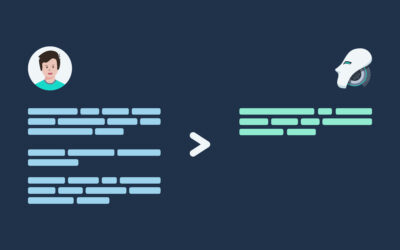Table of Content
Many businesses adopting Generative AI (GenAI) for various functions have reported improved revenues and reduced costs. These benefits are evident across multiple areas, including marketing and sales, product and service development, IT help desk chatbots, and more.
Explore the LangChain developer framework for integrating large language models (LLMs) into applications. Learn more about LangChain and how it simplifies the deployment, integration, and management of LLMs within generative AI app development.
This paper provides essential information about the concepts and components of LangChain, a popular AI tool that is revolutionizing how organizations leverage artificial intelligence for real-world applications.
LangChain–Open Source Development Framework
As the adoption of LLMs increases, the complexity of integrating these powerful models into existing systems becomes a significant barrier. Developers often struggle with the intricacies of model integration, which involves managing multiple prompts, interpreting diverse outputs, and writing extensive code to bind different application components together.
LangChain emerges as a solution by addressing these challenges head-on. It simplifies the integration process by providing a structured framework that standardizes the interaction between LLMs and application-specific logic.
By offering reusable components such as prompt templates and output parsers, LangChain drastically reduces the need for coding. This accelerates the development process and enhances applications’ maintainability and scalability.
Moreover, LangChain’s modular design allows developers to focus on crafting innovative features and improving user experiences rather than getting trapped within the complexities of LLMs.
LangChain reduces coding overhead, eases integration challenges, and enables developers to leverage LLMs’ transformative potential more effectively and efficiently. This makes it invaluable for the organization’s generative AI Strategy.
Retrieval Augmented Generation (RAG)
Retrieval Augmented Generation (RAG) is a powerful technique that enhances AI language models with up-to-date, specific information. LangChain provides tools to implement RAG use cases, allowing businesses to combine the general knowledge of large language models with their proprietary or specialized data. This results in AI applications that can provide more accurate, relevant, and contextually appropriate responses, particularly valuable in domains requiring current or company-specific information
LangChain Features and Methodologies
LangChain addresses the challenges associated with integrating and managing large language models (LLMs) in application development through several key features and methodologies:
Abstraction of Complexities
LangChain abstracts the complexities of handling LLMs by providing a higher-level framework that simplifies model prompting and output parsing. This abstraction reduces the need for developers to deeply understand the intricacies of the underlying AI technologies, allowing them to focus on application logic and user experience.
Modular Components
The framework offers modular components that can be easily integrated and reused across different parts of an application. This modularity facilitates the composition of complex functionalities without requiring extensive glue code, significantly speeding up the development process and reducing maintenance overhead.
Prompt Templates and Output Parsers
LangChain comes equipped with a set of predefined prompt templates and output parsers. These tools standardize how applications interact with LLMs, ensuring that prompts are consistently formatted and outputs correctly interpreted and structured. This standardization not only streamlines development but also enhances application reliability and consistency.
Community-Driven Enhancements
Being an open-source framework, LangChain benefits from community contributions and collaborative improvements. This community-driven development model ensures that LangChain stays updated with the latest AI and machine learning advancements, continuously evolving to meet new challenges and incorporate innovative solutions.
Reduction in Development Time
By reducing the amount of custom code required and offering tools that automate and simplify many aspects of LLM application development, LangChain drastically cuts down on development time. This efficiency enables developers to prototype and deploy LLM-based applications faster, facilitating quicker iterations and faster time-to-market.
Scalability and Flexibility
LangChain’s architecture is designed to be both scalable and flexible, accommodating applications of various sizes and complexities. Whether for small-scale projects or enterprise-level solutions, LangChain provides the tools and infrastructure to scale applications efficiently.
Framework Overview
The structural design of LangChain is centered around facilitating the integration and management of large language models (LLMs) within application development. Here’s an overview of its main components and their functionalities:
Modular Packages
LangChain offers two main packages in Python and JavaScript, enabling developers to either use individual components independently or integrate them.
Prompt Templates
LangChain’s Prompt Templates are a key feature streamlining how businesses interact with AI language models. These templates provide a structured, consistent approach to AI communication, offering significant benefits. They enhance efficiency by offering predefined, reusable templates for common scenarios, speeding up the development and deployment of AI applications.
Standardized prompts improve consistency across application parts, ensuring uniform interactions and more reliable AI responses. Designed to align with industry best practices, these templates help reduce errors and improve the quality of AI outputs.
They also simplify the development process, enabling developers to quickly establish new AI interactions without crafting each prompt from scratch, thus lowering the technical barriers to AI integration.
Output Parsers
LangChain’s Output Parsers are essential tools that transform raw AI-generated content into structured, business-ready data. By working together with prompt templates, parsers ensure that the outputs from language models are accurate and immediately usable within various business applications.
Output parsers interpret and reformat AI responses into standardized formats such as JSON or tabular data. This transformation is crucial for seamlessly integrating AI capabilities into existing business processes and systems. By providing consistently structured data, Output Parsers enable:
- Efficient data processing and analysis
- Easy integration with existing databases and applications
- Improved reliability in AI-driven decision-making processes
- Enhanced user experiences in AI-powered interfaces
By leveraging Output Parsers, businesses can ensure that the valuable insights generated by AI models are readily accessible and actionable across their operations. This capability significantly reduces the technical overhead in utilizing AI outputs, allowing companies to focus on deriving value from AI-generated insights rather than wrestling with unstructured data.
Chains
Chains in LangChain are modular components that combine language models, prompts, and other elements to create more complex and powerful applications. They serve as a fundamental building block for developing sophisticated AI systems by allowing users to link together multiple operations. Chains can range from simple combinations of a prompt and a language model to more intricate sequences that involve multiple steps, data retrieval, and decision-making processes.
They enable developers to create reusable and scalable workflows, making building advanced applications such as question-answering systems, document analysis tools, and intelligent agents easier. By using chains, stakeholders can leverage the full potential of large language models while maintaining flexibility and control over the application’s logic and behavior.
Indexing and Data Ingestion
Langchaing uses indexes to ingest data and combine it with models. This component is crucial for applications that require the integration of large datasets with LLMs for processing or analysis.
Agents
One of LangChain’s more advanced components is its implementation of agents. These agents use the model as a reasoning engine, enabling more sophisticated application decision-making processes. Agents represent a type of end-to-end use case that leverages the full capabilities of LLMs.
ReAct (Reasoning and Acting) is an advanced prompting technique designed to enhance the reasoning capabilities of large language models (LLMs) when used in agent-based systems. This technique is particularly relevant in the context of LangChain’s agent implementation.
Retrievers
Retrievers in LangChain are components that retrieve relevant information from a data source to answer questions or provide context for language models. They are particularly important in applications like question-answering systems over documents.
Retrievers fetch the most relevant documents or chunks of text based on a given query. They often work with vector stores–databases that store text embeddings (numerical representations of text that capture semantic meaning).
The primary method for retrievers is semantic search, which finds documents based on meaning rather than exact keyword matches.
Methods associated with retrievers:
1. Similarity Search: This is the basic method used by retrievers. It involves:
- Creating an embedding for the query
- Comparing this embedding to the vectors in the vector store
- Returning the N most similar chunks
2. Maximal Marginal Relevance (MMR): This method aims to provide diverse results by:
- Initially retrieving a larger set of documents based on similarity
- Then, selecting a subset that balances relevance with diversity
3. Self-Query: This method uses a language model to:
- Parse the input query
- Extract both semantic search terms and metadata filters
- Apply these to retrieve more precise results
4. Compression: While not strictly a retrieval method, it’s often used in conjunction with retrieval to:
- Extract the most relevant segments from retrieved passages
- Focus the final answer on the most important information
5. SVM and TF-IDF Retrievers: These are mentioned as alternative retrieval methods that don’t use vector databases but instead rely on more traditional NLP techniques.
Vector Stores
Vector stores are a crucial component in LangChain’s architecture, particularly for applications that involve retrieving and querying large amounts of text data. They are essentially databases designed to store and efficiently search through vector representations of text, known as embeddings.
Documents are loaded, split into chunks, converted into embeddings, and stored in the vector store using an embedding model. When questions are asked, they are also converted into embeddings using the same model. The vector store compares the question embeddings to all stored document embeddings and retrieves the most similar chunks. These retrieved chunks serve as a context for generating an answer.
Use Cases for LangChain
- Simple LLM Applications: Utilize LangChain Expression Language (LCEL) to build straightforward applications that leverage large language models for basic tasks.
- Chatbots: Create interactive chatbots that can handle various conversational scenarios and respond intelligently to user queries.
- Agents: Develop sophisticated agents capable of performing complex tasks and making decisions based on contextual information.
- Retrieval Augmented Generation (RAG) Applications:
- Build applications that dynamically retrieve and incorporate external information to enhance the generative capabilities of LLMs.
- Develop conversational RAG applications that integrate retrieval into dialogue systems for more informed responses.
- Question and Answering Systems:
- Implement systems that operate over SQL databases, allowing users to query structured data using natural language.
- Create systems that can ingest PDF documents and provide answers to questions based on the content.
- Query Analysis Systems: Develop systems that analyze and process queries to determine intent and relevant responses.
- Graph Database Applications: Build applications utilizing graph databases to store and query complex datasets.
- Extraction Chains: Create workflows that extract specific types of information from large datasets.
- Text Classification: Build systems that can classify text into predefined categories based on content.
- Text Summarization: Develop applications that summarize large texts into concise versions while retaining the key information.
Each use case demonstrates LangChain’s flexibility to cater to various applications, from simple task automation to complex data analysis and interaction systems. These examples also highlight how LangChain supports both the development and deployment phases of the application lifecycle (LLMOps), making it an invaluable tool for businesses and developers looking to leverage AI in their operations.
Contact a Krasamo AI engineer to discuss your use case needs.
Question Answering Systems
A question-answering system is a type of application that allows users to ask questions about specific documents or datasets and receive accurate answers. These systems are designed to answer questions based on the content of specific documents or data sources rather than just relying on the LLM’s pre-trained knowledge.
- Components:
- Document loaders: To import data from various sources (e.g., PDFs, websites, databases)
- Text splitters: To break documents into smaller, manageable chunks
- Embeddings: To create numerical representations of text chunks
- Vector stores: To store and efficiently retrieve relevant text chunks
- Retriever: To fetch the most relevant documents or chunks based on a query
- Language Model: To generate the final answer based on the retrieved information
- Retrieval Methods: Various methods (like similarity search, MMR, and self-query) are used to improve the relevance of retrieved documents.
- Answer Generation Methods: Different approaches (Stuff, MapReduce, Refine, MapRerank) are used to generate answers for multiple documents or large amounts of information.
Workflow for Building AI Chatbots with LangChain
An AI chatbot is a typical example of an application built using Langchain that demonstrates versatility.
- Environment Setup:
- Initialize LangChain environment.
- Load necessary libraries and APIs (e.g., OpenAI API key for interacting with language models).
- Data Loading:
- Document Loaders: Use LangChain’s document loaders to import data from various sources such as PDFs, websites, databases, and YouTube. This involves selecting the appropriate loaders for each data type (e.g., pypdf loader for PDFs, web-based loaders for websites).
- Standardization: Convert diverse data formats into a standardized document format with content and associated metadata.
- Data Preprocessing:
- Semantic Chunking: Split documents into semantically meaningful chunks. This process is crucial for managing the data size and focusing the LLM on relevant content for each query.
- Text Splitters: Use specific splitters that handle different types of content appropriately, ensuring that each chunk retains contextual relevance.
- Semantic Search Setup:
- Indexing: Apply indexing to the preprocessed data to facilitate efficient retrieval. This step is essential for setting up the semantic search that underpins the chatbot functionality.
- Embeddings and Vector Stores: Convert text chunks into embeddings and store these in a vector store for quick similarity searches.
- Query Processing and Response Generation:
- Query Handling: Receive user queries and process them using the LangChain setup.
- Document Retrieval: Utilize semantic search to fetch the most relevant document chunks based on the user’s query.
- LLM Prompting: Generate prompts for the LLM using the retrieved document chunks to form a coherent query context.
- Response Parsing: Parse the LLM’s output to construct a clear and accurate response to the user.
- Chatbot Interaction:
- Memory Management: Implement memory features to maintain context across multiple interactions, allowing the chatbot to handle follow-up questions effectively.
- User Interface: Develop and refine the user interface to facilitate interactions, ensuring users can easily input questions and view responses.
- Continuous Improvement and Scaling:
- Feedback Loop: Incorporate user feedback to refine prompts, adjust parsing strategies, and improve the overall interaction flow.
- Scalability Considerations: Monitor performance and scale the backend infrastructure to handle increased load and data volume.
- Community Contribution and Development:
- Engage with the LangChain community for support and updates.
- Contribute improvements and new features to the open-source project.
This workflow provides a comprehensive guide to leveraging LangChain to develop an AI chatbot that can interact dynamically with user-provided data, enhancing the accessibility and usability of stored information through conversational interfaces.
Ecosystem and Related Tools
LangSmith: LangSmith is a developer platform for debugging, testing, evaluating, and monitoring LLM applications. It is highlighted as an integral tool for ensuring applications are optimized and robust before and after deployment.
LangServe: LangServe is a deployment tool that transforms LangChain applications into REST APIs, making them accessible and scalable. It is emphasized for its role in the production readiness and deployment phase of LLM applications.
LangGraph: LangGraph is a framework for building stateful, multi-actor LLM applications. It provides a framework for defining complex workflows involving multiple agents or actors, each with its state and behavior. LangGraph is ideal for applications requiring long-term memory, agent-based simulations, and complex decision-making processes.
LangChain Expression Language (LCEL)
LangChain Expression Language (LCEL) is a declarative language that facilitates the chaining of LangChain components for building scalable and robust AI applications. Designed to transition prototypes seamlessly into production environments, LCEL supports the simplest to the most complex workflows, enabling applications to run efficiently with hundreds of steps in production settings.
LCEL excels in providing first-class streaming support, optimized parallel execution, and asynchronous operations, ensuring minimal latency and high responsiveness across diverse AI tasks. These features make LCEL indispensable for developers looking to implement advanced generative AI functionalities with high reliability and customizability.
Krasamo’s AI Development Services
- AI Development Services
- Data Science
- Prompt Engineering
- Python Developers
- Testing LLMs
References
[1] Build an Agent
[2] LangChain Conceptual Guide
[3] LangChain How-To Guides
[4] LangChain Expression Language (LCEL)
[5] LangGraph.js
[6]Get Started with LangSmith












0 Comments